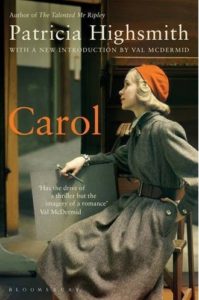as The Price of Salt 1951; as Carol 2016
 At least in my circles, Todd Haynes’ new film Carol created quite a buzz. After all, it’s still quite a rarity to see a movie about a same sex relationship that doesn’t end in tears. In 1951, when The Price of Salt was first published, it was unheard of, not just in movies but also in books. Censorship, both official and soft, meant publishers were unwilling to produce books about same sex relationships. Pulp lesbian fiction, which because of said censorship ended in death or in the blessed powers of the healing cock, was pretty much it for the ladies. In terms of fiction, men had even less to turn to.
At least in my circles, Todd Haynes’ new film Carol created quite a buzz. After all, it’s still quite a rarity to see a movie about a same sex relationship that doesn’t end in tears. In 1951, when The Price of Salt was first published, it was unheard of, not just in movies but also in books. Censorship, both official and soft, meant publishers were unwilling to produce books about same sex relationships. Pulp lesbian fiction, which because of said censorship ended in death or in the blessed powers of the healing cock, was pretty much it for the ladies. In terms of fiction, men had even less to turn to.
Patricia Highsmith was an established and respected novellist when she wrote The Price of Salt. Though the risks she took in writing and then seeking to have published the novel are somewhat underplayed, they did exist. We’re talking an era just shortly before McCarthyism because America’s hot new buzzword. And as well know, communism and homosexuality go together like whiskey and coke.
Pulp fiction Carol is not. And fortunately, unlike Radclyffe Hall’s The Well of Loneliness it wasn’t terrible. I had feared that, like The Well of Loneliness, Carol might have only been popular because that was all old timey same sex attracted women had. Rather, Carol is a beautifully crafted and atmospheric novel, low on the erotic tones the film played with (for several understandable reasons), but heavy on the romance and togetherness.
Early 1950s New York is evoked with little of the glamour pop culture throws at us. Therese Belevit is a working woman, and the soul destroying drudgery of her life and potential future in retail are shown in unforgiving detail. In her early 20s, Therese feels directionless and unattached to the people in her life. Then a chance workplace encounter with Carol provides her with the spark not just of love, but of opportunity. Like in any romance, Therese’s relationship with Carol is the catalyst for a change in her life. Carol, meanwhile, suffers from her unwillingness to conform with society’s expectations of the housewife.
I generally consider it pointless to compare films and books, but I did want to note one point. In Carol the film, Therese’s relationship with Carol quickly becomes the only relationship she cares about. I was relieved that in the book, Therese had, maintained and developed friendships with several other characters in the story. It is a much healthier relationship that allows room for friends.
Carol should be a joy for anyone to read, whether same sex attracted or not, woman or not.

